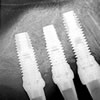Hydraulic Sinus Condensing (HSC) for Implant Placement
The More Predictable and Less Invasive 21st Century Sinus Augmentation
 Technique
TechniqueBackground of Hydraulic Sinus Condensing (HSC)Technique
Developed by Leon Chen, D.M.D., M.S., Hydraulic Sinus Condensing, is today’s premier technique for sinus augmentation. Dr. Chen has demonstrated this
 technique to sold-out crowds at the annual meeting of the American Academy of Periodontology, the European Federation of Periodontology, and other academy meetings.
technique to sold-out crowds at the annual meeting of the American Academy of Periodontology, the European Federation of Periodontology, and other academy meetings.To read an interview about Hydraulic Sinus Condensing, please click here.
An 8-year retrospective study: 1,100 patients receiving 1,557 implants using the minimally invasive hydraulic sinus condensing technique. Chen L, Cha J.
J Periodontol. 2005 Mar;76(3):482-91
Clinical procedure:






New Technique by Dr. Smiler?? :

Balloon Subantral Membrane Elevator ( SME )
The advantages of Subantral Membrane Elevator, or SME:
Decreases Surgical Time
Reduces Risk of Membrane Tears
Mini Balloon Inflates to 3.1mm
(Micro Mini Inflates to 1.9mm)
Single Use, Supplied Sterile
Supplied with 5cc Luer Lok® Syringe
Can be used in small osteotomies


*Effects of sealing the perforated sinus membrane with a resorbable collagen membrane: a pilot study in humans.
J Oral Implantol. 2003;29(5):235-41
Proussaefs P, Lozada J, Kim J.
Graduate Program in Implant Dentistry, Loma Linda University, Loma Linda, CA 92350, USA.
The effects of repairing the perforated sinus membrane with collagen membrane are unknown. The purpose of this pilot study was to clinically, histologically, and histomorphometrically evaluate the results of repairing the perforated sinus membrane with resorbable collagen membrane. A split-mouth design was followed in the current study. Five subjects requiring bilateral sinus grafting were included in the study, where one site was accidentally perforated during sinus augmentation procedures and the other site was not perforated. The perforated sites were repaired with a resorbable collagen membrane. Dental implants were placed at a second stage and biopsies were harvested from both sinuses. New bone formation was measured for all sites. Implant survival was recorded at second-stage surgery. Nonperforated sites demonstrated significantly more bone formation (34.40%) than perforated sites (12.80%) (P = .016). Implant survival at second-stage surgery was significantly inferior in perforated sites (54.5%) when compared with nonperforated sites (100%) (P = .0146). The study demonstrated that perforation and repair of the Schneiderian membrane can compromise new bone formation and implant survival rate.




0 Comments:
Post a Comment
<< Home